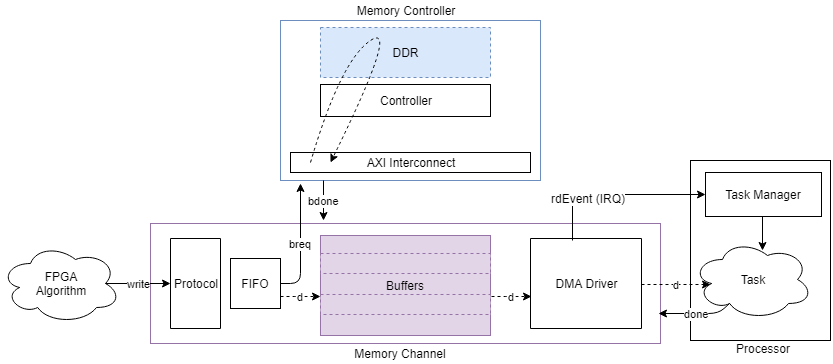Memory and Register Data Transfers
An SoC application is composed of one or more algorithms. When an algorithm transfers data to another algorithm, the data is represented as a signal line in Simulink®. For behavioral models, the data transfer is instantaneous.
This diagram shows a behavioral model of a datapath between two algorithms.

In the physical world, the algorithms can be on two separate devices, and data transfers do not happen instantaneously. Furthermore, the algorithms can run at different rates, and therefore require buffering and control logic for handshaking. For example, a simple handshake such as “data is valid” from the producer of the data and “ready to accept data” from the consumer serve as control logic.
If one processing element executes in an FPGA or ASIC, and the next processing element executes on an embedded processor, then a simple signal line represents more than just a complex hardware datapath. The data transfer also represents a processor interrupt handler, an operating system task scheduler, and a software driver stack.
In SoC Blockset™, you model data transfers and handshake protocols through shared memory. Use a Memory Channel block for external memory or a Register Channel block for registers.
Modeling Datapath with Memory Channel Block
The Memory Channel block represents an abstraction to a complex datapath through external memory and supports different handshake protocols. It facilitates a refinement of the communication between processing elements from an instantaneous, protocol-less wire to a full direct memory access (DMA) connection between a processor and an FPGA.
By adding a Memory Channel block, you can model data movement from one part of the algorithm to another.

The block provides a model of the communication pipeline. The channel also provides a signaling interface.

The interface protocol depends on where the processing is executed. An FPGA or ASIC algorithm can perform data transfers by using standard protocols such as AXI4-Stream or AXI4. An embedded CPU algorithm can use a driver-interface exported to the user space.
This figure shows a model of the datapath from an FPGA algorithm streaming data to a processor algorithm.

Other Memory Channel type selections model additional common datapaths through external memory. For more information about Memory Channel configurations, see Memory Channel.
The writer and reader are connected to the memory and request access to the external memory from a memory controller. For more information about the Memory Controller block, see Memory Controller.
Modeling Datapath with Register Channel Block
The Register Channel block represents the serialization of the processor reads or writes through a common configuration bus such as AXI-Lite.
The Register Channel block provides a timing model for the transfer of register values between processor and hardware algorithms through a common configuration bus. Use this block when the processor writes a command or configuration register or when the processor reads a status register.
See Also
Memory Channel | Register Channel